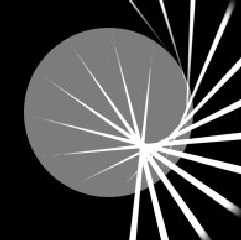Thomas Willhalm <Tho### [at] uni-konstanz de> schrieb in im Newsbeitrag:
qqm### [at] horn de> schrieb in im Newsbeitrag:
qqm### [at] horn fmi fmi uni-konstanz uni-konstanz de...
> "Matthias" <sma### [at] t-online de...
> "Matthias" <sma### [at] t-online de> writes:
>
source
> > as only parameters. If anyone tried something like this so far please
tell
> > me so I can spare time!
> > Help with the media parameters to make the very thin lightrays visible
is
> > also welcome.
> > Thanks
> > Smarf :)
>
> Perhaps you should have a look at my disco ball. It is probably quite
> easy to convert it to a macro. At the time when I created the image,
> Nathan's photon map patch didn't exist. That's why I included the
> "virtual" spot light sources to get the reflected lights. Using Nathan's
> patch this is now obsolete.
>
> The scene uses a halo to make the light beams visible. So, fiddling
> around with the media will be your job. :-)
>
> The image as well as the source code and an animation can be found at
> http://www.fmi.uni-konstanz.de/~willhalm/graphics/tracegallery/index.html
>
> Feel free to ask when you have further questions.
>
> Thomas
>
> --
> http://www.fmi.uni-konstanz.de/~willhalm
Great!!
Lighteffect.
Is it OK if I copy a few lines of your file? Of course your name will appear
the virtual Lights anyway for I just finished my own Simulation with
spotlights instead of cylinders. They have the advantage that the Rays get
"thicker" the longer they travel- like in reality, but the disadvantage of
being not existent at their origin, so I put the Light_sources inside the
Ball which means that it has to be a no shadow object.(see Picture)
The other possibility you mentioned - the patch - seems to be interesting
too. I usually am no fan of patches but wait until they appear as part of
caustics with this Photon-map feature?
Matthias de> writes:
>
source
> > as only parameters. If anyone tried something like this so far please
tell
> > me so I can spare time!
> > Help with the media parameters to make the very thin lightrays visible
is
> > also welcome.
> > Thanks
> > Smarf :)
>
> Perhaps you should have a look at my disco ball. It is probably quite
> easy to convert it to a macro. At the time when I created the image,
> Nathan's photon map patch didn't exist. That's why I included the
> "virtual" spot light sources to get the reflected lights. Using Nathan's
> patch this is now obsolete.
>
> The scene uses a halo to make the light beams visible. So, fiddling
> around with the media will be your job. :-)
>
> The image as well as the source code and an animation can be found at
> http://www.fmi.uni-konstanz.de/~willhalm/graphics/tracegallery/index.html
>
> Feel free to ask when you have further questions.
>
> Thomas
>
> --
> http://www.fmi.uni-konstanz.de/~willhalm
Great!!
Lighteffect.
Is it OK if I copy a few lines of your file? Of course your name will appear
the virtual Lights anyway for I just finished my own Simulation with
spotlights instead of cylinders. They have the advantage that the Rays get
"thicker" the longer they travel- like in reality, but the disadvantage of
being not existent at their origin, so I put the Light_sources inside the
Ball which means that it has to be a no shadow object.(see Picture)
The other possibility you mentioned - the patch - seems to be interesting
too. I usually am no fan of patches but wait until they appear as part of
caustics with this Photon-map feature?
Matthias
Post a reply to this message
Attachments:
Download 'MIrrorb1.jpg' (9 KB)
Preview of image 'MIrrorb1.jpg'

|




![]()